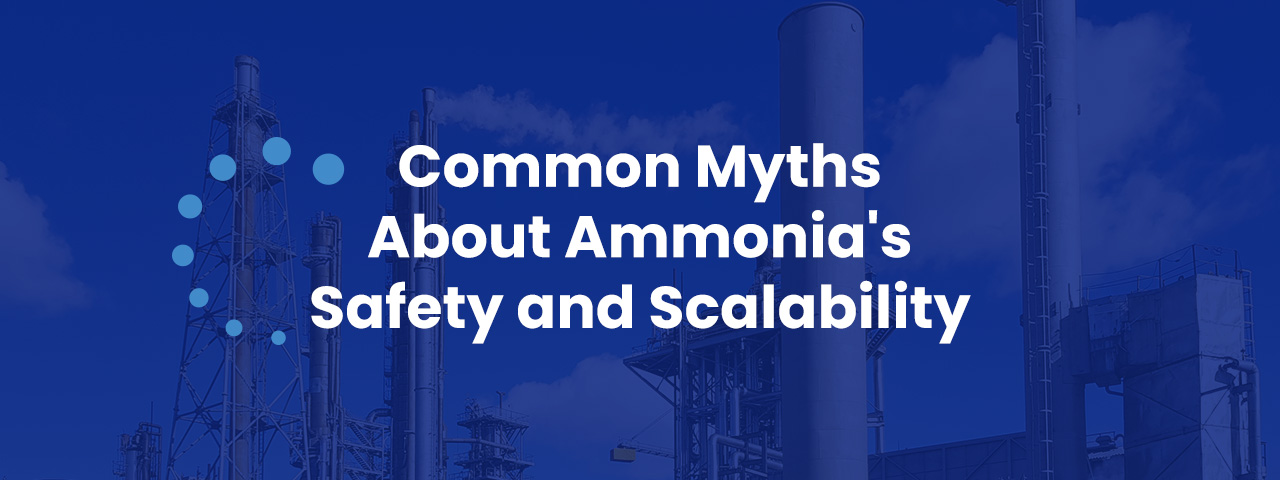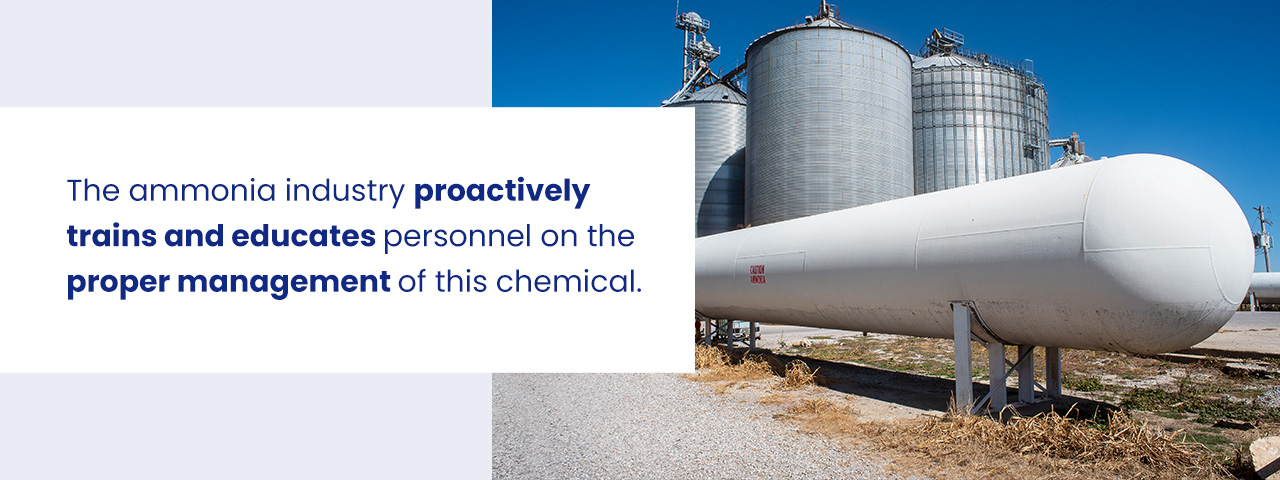December 27, 2024
Common Myths About Ammonia’s Safety and Scalability

Ammonia (NH3) is a colorless, pungent, inorganic chemical compound containing nitrogen and hydrogen. This corrosive substance compresses easily, forming a clear liquid under pressure. As one of the most frequently produced industrial chemicals in the United States, it’s essential for various biological processes.
This compound is used as a fertilizer to enrich crops and feed the world’s population, with about 80% of ammonia produced as agricultural fertilizer. It has many other applications, such as manufacturing plastics, textiles, explosives, dyes and pesticides. You’ll find it in many standard household and industrial-strength cleaning products.
Ammonia’s Potential Role in the Energy Industry
Ammonia is being considered as an alternative fuel to help decarbonize energy consumption. Its high energy density makes it a promising candidate in industries like power generation and maritime shipping.
However, much controversy surrounds the ammonia market’s safety, scalability and environmental impact. For instance, the U.S. National Science Foundation found that widespread ammonia use in the energy sector could increase nitrous oxide emissions, which is about 300 times more potent than carbon dioxide.
This post aims to disprove common misconceptions about ammonia as a fuel. Below, we’ll dive into these myths surrounding ammonia’s production and applications.
4 Ammonia Safety Myths
First, let’s debunk some common safety myths about ammonia:
1. Ammonia’s Safety Characteristics Are Uncertain
In reality, ammonia’s safety characteristics are well-known, and its risks are manageable. Its odor can be identified in concentrations as low as 5 parts per million (ppm). Gaseous ammonia can dissipate quickly since it’s less dense than air, reducing the risk of fires and explosions.
The ammonia industry proactively trains and educates personnel on the proper management of this chemical. Ammonia has been used in agricultural and industrial settings for over a century. Additionally, the industry has partnered with various international government agencies and trade groups, creating safety guidelines and regulations tailored to specific ammonia applications and handling. These regulations include:
- The Ammonia Health and Safety Guide, published jointly in 1990 by the World Health Organization, the United Nations Environment Programme and the International Labour Organization.
- Extensive information and standards for working with anhydrous ammonia, published by the Occupational Safety and Health Administration (OSHA).
Furthermore, institutions like the International Maritime Organization (IMO) are discussing regulations for safe ammonia bunkering (refueling cargo ships).
2. Ammonia Production Requires Fossil Fuels That Emit CO2
While ammonia itself doesn’t contain carbon, about 98% of today’s ammonia production uses fossil fuels as feedstock. However, immediate steps can be taken to minimize carbon dioxide emissions using carbon capture and storage (CCS) technology. Eventually, the use of zero-carbon hydrogen created from renewable electricity will produce ammonia that’s carbon-free through its service life.
Manufacturing ammonia without fossil fuels is feasible, though fossil fuel-free production accounts for a small percentage of ammonia output. As technology advances and encourages the adoption of zero-carbon ammonia, the percentage of ammonia from fossil fuel feedstocks is expected to decline.
3. Ammonia Cracking Uses New, Untested Technology
The truth is that ammonia cracking — a process that breaks ammonia back down into hydrogen and nitrogen — has been around for over 100 years. It only continues to improve in operating temperature and efficiency. Worldwide, plans are being developed to scale ammonia decomposition technology to larger capacities, enabling hydrogen to be carried over long distances.
During the cracking process, ammonia is pressurized and heated to break it apart into three hydrogen molecules and one nitrogen molecule. It typically uses a catalyst, which poses challenges with the endothermic heat and high temperature needed to stimulate and sustain the chemical reaction. Ammonia cracking is performed at a lower capacity due to these challenges.
Despite these obstacles, ammonia cracking is not a new technology. It has undergone thorough safety testing over the last century. In fact, ammonia cracking technology is already commercially available.
4. Ammonia for Power Generation and Transport Releases Toxic Greenhouse Gases
In truth, ammonia’s nitrogen oxide (NOx) emissions can be significantly reduced or even prevented altogether. While ammonia combustion produces NOx, a potent greenhouse gas, existing technology can be used to capture the remaining nitrogen oxides. Additionally, ammonia can be cracked to release its energy for power generation and transportation without emitting NOx.
4 Ammonia Scalability Myths
Next, we’ll look at some myths surrounding ammonia’s market flexibility:
1. Ammonia Won’t Become Cost-Competitive With Fossil Fuels
Ammonia is currently more expensive than many fossil fuels. However, when comparing dollars per energy unit, blue ammonia is already cost-competitive with fossil oils. Green ammonia can also compete with other carbon-free fuels and is expected to rival the cost of fossil oils in the coming decades. As green hydrogen becomes more cost-effective, so will green ammonia.
According to the International Renewable Energy Agency (IRENA), new green ammonia plants cost around $720-$1,400 per ton to produce. By 2030, this price is projected to drop to $480 per ton, followed by $310 per ton by 2050.
2. Current Policies Are Sufficient to Create New Ammonia Markets
In most countries, existing policies to incentivize the ammonia-to-power industry are inadequate. Without sufficient levels of assurance that ammonia will have a steady market as a fuel source after production, subsidizing production won’t be enough.
Government policies in numerous countries support alternative fuels, but the ammonia market will require a bigger push. For instance, the Inflation Reduction Act (IRA) provides up to $3 per kilogram of hydrogen production and CCS tax credits. For blue ammonia, this could yield subsidies of $100-$150 per ton. For green ammonia, it could result in subsidies of up to $300 per ton. However, these incentives can’t be stacked or used for the same project.
IRA subsidies are certainly helpful, but uncertainty about demand suggests that supply-driven incentives aren’t enough to produce sound results. Companies likely won’t build out their infrastructures significantly without at least some demand security.
3. Ammonia Will Have a Minimal Role in Emerging Power Systems
Ammonia-to-power technology offers solutions to decarbonize power generation, opening the door to further adoption and storage of renewable electricity. As more countries — particularly those shifting away from liquified natural gas and coal — see increased pressure to decarbonize and influxes in power demands, ammonia will likely play a key role in electric systems.
Global electricity demand is projected to increase by 3.4% annually through 2026, requiring lower-carbon options. Existing grid systems must be decarbonized before increased power demand can even be considered.
4. Ammonia Supply Won’t Be Enough to Decarbonize Shipping and Heavy Transport
Driven by a thriving fertilizer market, the ammonia sector boasts a well-established market with substantial room for growth. Nearly 200 million tons of ammonia is produced annually. Most of this production occurs in countries with extensive fossil fuel supplies, ensuring lower manufacturing costs, abundant future feedstock and sufficient room for increased ammonia production.
The Haber-Bosch method — a process that directly synthesizes ammonia from nitrogen and hydrogen — demonstrates that ammonia production can scale with growing demand. Additionally, modern technologies with zero-carbon production pathways can help support and diversify global ammonia supply.
With close coordination, ammonia production can increase to meet new areas of demand while fulfilling its traditional role as fertilizer feedstock.
Find High-Pressure Filters for Your Applications
When working with risky substances and chemicals, you’ll want durable filters for safe handling. At Chase Filters & Components, we offer a wide selection of high-pressure filters for air, gas, water, hydraulic fluids and engine lubricants. We serve various industries, including alternative fuels, agriculture, aerospace, oil and gas, chemical processing and more.
Browse our products online today, or contact our team with any questions.

